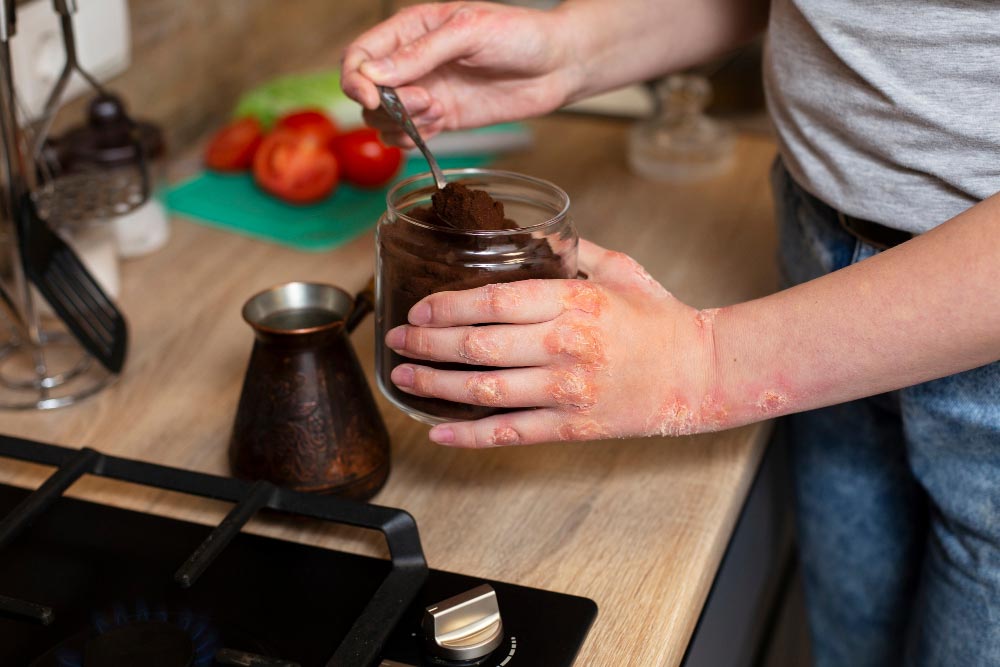Does your skin itch or get easily inflamed from time to time? It might be eczema. Though it is common for people with asthma to often have allergies that come with itchy, red skin, eczema actually affects over 15 million people in the US alone. It is pretty common in children but is no exemption in adults. Even though it is not contagious, symptoms could worsen over time without medication. Generally, eczema can cause dark, rough, scaly, or leathery patches on the skin and swelling, oozing, and crusting.
Below are types of eczema and their triggers:
Atopic dermatitis
Also known as the most common form of eczema, atopic dermatitis, often becomes evident in childhood.
Children who have one parent who has it are more likely to have it. Symptoms could range from mild to severe, from food sensitivity to hay fever. Atopic dermatitis usually could be found on the creases of the face, neck, wrists, elbows and knees. Scratching the irritated area makes it worse and causes the skin to produce clear fluid. Repeated scratching over a period of time also causes lichen simplex chronicus (LSC) which causes the irritated area of the skin to thicken.
Though children may outgrow Atopic dermatitis, repeated flare-ups in adults make it worse over time. Triggers may include:
- Weather: low humidity, cold weather, and extreme changes in temperature
- Irritants: detergents, soaps, perfumes, and fragrances
- Animal contact: dust mites, animal hair, and saliva
- Existing skin infections: like scabies
- Fabrics: wool and synthetics
- Some Hormonal changes: before menstrual periods or during pregnancy
- Existing food allergies
Contact dermatitis
Unlike Atopic dermatitis, this kind of eczema is neither genetically inherited from a parent, nor linked to symptoms like asthma and hay fever. This kind is caused by coming in contact with harmful or irritating chemicals and substances. There are also two types of what is classified as contact dermatitis: the irritant and the allergic type.
Irritant contact dermatitis starts with breakage on the skin caused by irritation, scratching, or accidental tear.
Allergic contact dermatitis is an effect of a robust inflammatory reaction by the immune system to an allergen. It usually lasts a few days.
Dyshidrotic eczema
Also known as pompholyx eczema, usually appears as small blisters with intense itching, commonly on the hands and feet. The blisters could get large and watery, leading to swelling, pain, and even pus. Blisters typically clear up in a few weeks but are known to leave the skin cracked and dry. It is unclear what triggers it, but people with Atopic dermatitis and fungal infections are said to be more prone to have it. People who also work with chemicals or require their hands immersed in water throughout the day are at greater risk of having it.
Discoid eczema
This is also called nummular eczema. It is distinctly recognizable because they look like disc-shaped patches of itchy, red, cracked, and swollen skin. Usually found on the lower legs, torso, and forearms, it is unclear how it is developed.
It happens to people of different ages and is common to people with dry skin, skin injuries (such as friction or burns), insect bites, poor blood flow, bacterial skin infections, allergy to certain medications, and chemicals like metals and formaldehyde. It is also common in people with a history of Atopic dermatitis.
Varicose eczema
This is also known as venous, gravitational, or stasis eczema, most commonly happens in adults suffering from varicose veins. As older people tend to be less active, the veins weaken in their legs which could both cause them to have varicose veins and varicose eczema. Varicose eczema typically occurs on the lower leg as hot, itchy spots or blisters, dry, scaly, weepy, crusty patches or cracked skin. Avoiding scratching the irritated skin could help it heal faster.
Asteatotic eczema
This is also called xerotic eczema, and eczema craquelé commonly affects people aged 60 years and above. As the skin gets drier as people get older, this kind of eczema usually appears on the legs but could also be found in other areas of the body. It causes cracked, dry skin with a distinct appearance of crazy paving, pink or red cracks or grooves, scaling, itching and soreness. It could be triggered by dry, cold weather, hot baths, soaps and other detergents, excessive cleaning or scrubbing of the skin or rough towel drying.
Seborrheic dermatitis
For infants, it usually occurs on the scalp and is called dandruff. For adults, it causes the skin to fall off in flakes around the areas of eyebrows, sides of the nose, the area behind the ears, groin, and center of the chest. It may be due to an overgrowth of a type of yeast that normally lives in these areas, as well as an overgrowth and rapid shedding of cells on the scalp.
Neurodermatitis
This often affects the areas like the back, sides or back of the neck, genitals, scalp, wrists, ankles, inside and behind the ears. This kind of eczema could be caused by scratching areas of the body during sleep or without realizing it. The areas scratched begin to thicken, darken, and be wrinkly as an effect of the irritation.
Though symptoms vary for each type of eczema, there are overlaps with some of its different triggers. After years of having this condition, some triggers are still left undetermined. However, the general dermatologist’s recommendation includes shifting to a healthier diet, increasing body movement (like exercise), lowering levels of stress, recognizing triggers, using products that are for sensitivity-prone skin, and maintaining a clean environment. You can also check eczema clinical trials if you want to help find possible breakthroughs for this disease. Generally, as soon as symptoms are observed, seek help from your dermatologist or health service provider to get proper treatment.
